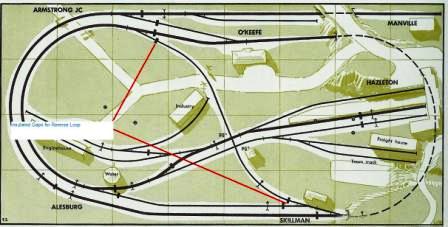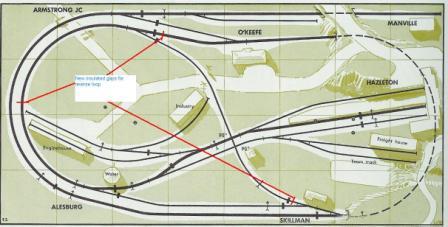The Texas & Southwestern has a reversing loop, and DCC insures reliable and simple operation of trains in the reverse loop. This reverse loop is handled with a Digitrax AR1 Auto Reversing Controller. The automated features of the AR-1 make for seamless train movements, but an issue quickly arose. Because a reverse loop in a traditional DC-powered model railroad environment required manual operation, the track insulating gaps for the loop were usually located for the convenience of the operators. So the track gaps of the original track plan were situated to keep this inconvenience to a minimum. Note also all the other insulated track gaps that were required for traditional DC operation.

Initially, the two gaps for the reverse loop were established at the points marked on the original track plan. Several other gaps were also placed, with an eye toward the possible need for future power expansion or train detection; these segments of track were then joined together with Kato 24-827 three-way extension cords and then connected to the Zephyr. The reverse loop is managed by an AR1 Automatic Reverse Section Controller. When a train enters into the reversing segment, the AR1 senses track power phase between the reversing section and the rest of the railroad and then automatically matches the two. As originally constructed, the reverse loop was defined by insulated joiners at the original points specified in the track plan. The AR1 was connected to the reverse loop and the power bus, and everything worked well when locomotives were operated to test the wiring. However, when lighted passenger cars were added to the locomotive, passage through the reverse loop resulted in a short circuit. This happens because the passenger cars have electrical pickups in their wheels and the train was long enough to cause electrical bridging between the main railroad and the automated reverse loop. So, the automated reversing segment was lengthened so that the longest train would be entirely within the reverse loop.

Because of the automated feature of the AR1, it does not matter if a train operating on the regular portion of the oval (from O'Keefe to Skillman) has to pass through the reversing area. The train operator never knows that the AR1 is in operation.
Many thanks to Mr. Riley O'Connor for sharing the Texas & Southwestern with us!